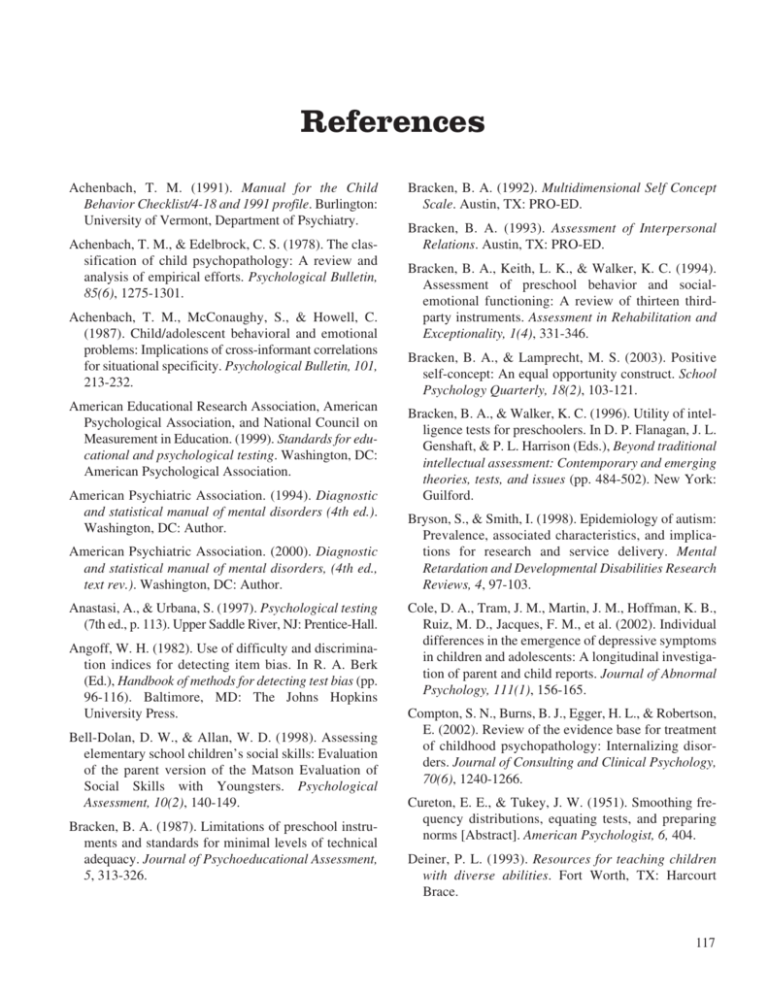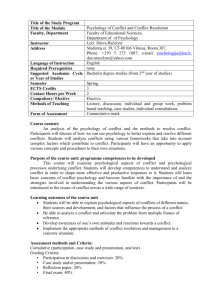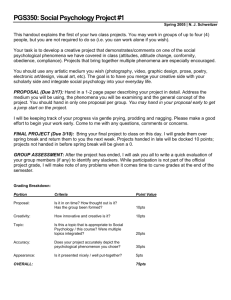CAB Manual - Psychological Assessment Resources, Inc.
advertisement

References Achenbach, T. M. (1991). Manual for the Child Behavior Checklist/4-18 and 1991 profile. Burlington: University of Vermont, Department of Psychiatry. Achenbach, T. M., & Edelbrock, C. S. (1978). The classification of child psychopathology: A review and analysis of empirical efforts. Psychological Bulletin, 85(6), 1275-1301. Achenbach, T. M., McConaughy, S., & Howell, C. (1987). Child/adolescent behavioral and emotional problems: Implications of cross-informant correlations for situational specificity. Psychological Bulletin, 101, 213-232. American Educational Research Association, American Psychological Association, and National Council on Measurement in Education. (1999). Standards for educational and psychological testing. Washington, DC: American Psychological Association. American Psychiatric Association. (1994). Diagnostic and statistical manual of mental disorders (4th ed.). Washington, DC: Author. American Psychiatric Association. (2000). Diagnostic and statistical manual of mental disorders, (4th ed., text rev.). Washington, DC: Author. Anastasi, A., & Urbana, S. (1997). Psychological testing (7th ed., p. 113). Upper Saddle River, NJ: Prentice-Hall. Angoff, W. H. (1982). Use of difficulty and discrimination indices for detecting item bias. In R. A. Berk (Ed.), Handbook of methods for detecting test bias (pp. 96-116). Baltimore, MD: The Johns Hopkins University Press. Bell-Dolan, D. W., & Allan, W. D. (1998). Assessing elementary school children’s social skills: Evaluation of the parent version of the Matson Evaluation of Social Skills with Youngsters. Psychological Assessment, 10(2), 140-149. Bracken, B. A. (1987). Limitations of preschool instruments and standards for minimal levels of technical adequacy. Journal of Psychoeducational Assessment, 5, 313-326. Bracken, B. A. (1992). Multidimensional Self Concept Scale. Austin, TX: PRO-ED. Bracken, B. A. (1993). Assessment of Interpersonal Relations. Austin, TX: PRO-ED. Bracken, B. A., Keith, L. K., & Walker, K. C. (1994). Assessment of preschool behavior and socialemotional functioning: A review of thirteen thirdparty instruments. Assessment in Rehabilitation and Exceptionality, 1(4), 331-346. Bracken, B. A., & Lamprecht, M. S. (2003). Positive self-concept: An equal opportunity construct. School Psychology Quarterly, 18(2), 103-121. Bracken, B. A., & Walker, K. C. (1996). Utility of intelligence tests for preschoolers. In D. P. Flanagan, J. L. Genshaft, & P. L. Harrison (Eds.), Beyond traditional intellectual assessment: Contemporary and emerging theories, tests, and issues (pp. 484-502). New York: Guilford. Bryson, S., & Smith, I. (1998). Epidemiology of autism: Prevalence, associated characteristics, and implications for research and service delivery. Mental Retardation and Developmental Disabilities Research Reviews, 4, 97-103. Cole, D. A., Tram, J. M., Martin, J. M., Hoffman, K. B., Ruiz, M. D., Jacques, F. M., et al. (2002). Individual differences in the emergence of depressive symptoms in children and adolescents: A longitudinal investigation of parent and child reports. Journal of Abnormal Psychology, 111(1), 156-165. Compton, S. N., Burns, B. J., Egger, H. L., & Robertson, E. (2002). Review of the evidence base for treatment of childhood psychopathology: Internalizing disorders. Journal of Consulting and Clinical Psychology, 70(6), 1240-1266. Cureton, E. E., & Tukey, J. W. (1951). Smoothing frequency distributions, equating tests, and preparing norms [Abstract]. American Psychologist, 6, 404. Deiner, P. L. (1993). Resources for teaching children with diverse abilities. Fort Worth, TX: Harcourt Brace. 117 DuPaul, G. J., Power, T. J., Anastopoulos, A. D., Reid, R., McGoey, K. E., & Ikeda, M. J. (1997). Teacher ratings of attention-deficit/hyperactivity disorder symptoms: Factor structure and normative data. Psychological Assessment, 9(4), 436-444. Edelbrock, C. (1983). Problems and issues in using rating scales to assess child personality and psychopathology. School Psychology Review, 12(3), 293-299. Education for All Handicapped Children Act 1975, Pub. L. No 94-142 (1975). Fox, J. A., Elliott, D. S., Kerlikowske, R. G., Newman, S. A., & Christeson, W. (2003). Bullying prevention is crime prevention. Fight crime: Invest in kids. Retrieved from the Fight Crime: Invest in Kids Web site: http:www.fightcrime.org/reports/Bullying Report.pdf. Goh, D. S., & Fuller, G. B. (1983). Current practices in the assessment of personality and behavior by school psychologists. School Psychology Review, 12(3), 240-243. Guilford, J. P. (1954). Psychometric methods (2nd ed.). New York: McGraw-Hill. Han, S. S., Weisz, J. R., & Weiss, B. (2001). Specificity of relations between children’s control-related beliefs and internalizing and externalizing psychopathology. Journal of Consulting and Clinical Psychology, 69(2), 240-251. Harrison, P., & Oakland, T. (2000). Adaptive Behavior Assessment System. San Antonio, TX: The Psychological Corporation. Huebner, E. S., & Gilman, R. (2003). Toward a focus on positive psychology in school psychology. School Psychology Quarterly, 18, 99-102. Individuals With Disabilities Education Act Amendments of 1997, Pub. L. No. 103-218 (GPO 1997). Kamphaus, R. W., DiStefano, C., & Lease, A. M. (2003). A self-report typology of behavior adjustment for young children. Psychological Assessment, 15(1), 17-28. Kamphaus, R. W., Petoskey, M. D., & Rowe, E. W. (2000). Current trends in psychological testing of children. Professional Psychology: Research and Practice, 31(2), 155-164. 118 Kavale, K. A., Forness, S. R., & Alper, A. E. (1986). Research in behavioral disorders/emotional disturbance: A survey of subject identification criteria. Behavioral Disorders, 11(3), 159-167. Keiley, M. K., Lofthouse, N., Bates, J. E., Dodge, K. A., & Petit, G. S. (2003). Differential risks of covarying and pure components in mother and teacher reports of externalizing and internalizing behaviors across ages 5 to 14. Journal of Abnormal Psychology, 31(3), 267-283. Knoff, H. M. (Ed.). (1986). Identifying and classifying children and adolescents referred for personality assessment: Theories, systems, and issues. In The assessment of child and adolescent personality (pp. 3-31). New York: Guilford. Kronenberger, W. G., & Meyer, R. G. (2001). The child clinician’s handbook (2nd ed.). Boston: Allyn & Bacon. Martin, R. P. (1988). Assessment of personality and behavior problems: Infancy through adolescence. New York: Guilford. Martin, R. P., Hooper, S., & Snow, J. (1986). Behavior rating scale approaches to personality assessment in children and adolescents. In H. M. Knoff (Ed.), The assessment of child and adolescent personality (pp. 309-351). New York: Guilford. Merrell, K. W. (1994). Assessment of behavioral, social, and emotional problems: Direct and objective methods for use with children and adolescents. New York: Longman. Naglieri, J. A., LeBuffe, P. A., & Pfeiffer, S. I. (1994). Devereux Scales of Mental Disorder. San Antonio, TX: The Psychological Corporation. Nansel, T. R., Overpeck, M., Pilla, R. S., Ruan, W. J., Simons-Morton, B., & Scheidt, P. (2001). Bullying behaviors among U.S. youth: Prevalence and association with psychosocial adjustment. Journal of the American Medical Association, 285, 2094-2100. Novick, J., Rosenfeld, E., Bloch, D. A., & Dawson, D. (1966). Ascertaining deviant behavior in children. Journal of Consulting Psychology, 30(3), 230-238. Nunnally, J. (1978). Psychometric theory (2nd ed.). New York: McGraw-Hill. Prout, H. T. (1983). School psychologists and socialemotional assessment techniques: Patterns in training and use. School Psychology Review, 12(4), 377-383. Reynolds, C. R., & Kamphaus, R. (1998). Behavior Assessment System for Children. Circle Pines, MN: American Guidance Service. Sattler, J. M. (2001). Assessment of children: Cognitive applications (4th ed.). San Diego, CA: Author. Seligman, M. E. P. (2002). Authentic happiness: Using the new positive psychology to realize your potential for lasting fulfillment. New York: Free Press. Seligman, M. E. P., & Csikzentmihalyi, M. (2000). Positive psychology: An introduction. American Psychologist, 55(1), 5-14. Smith, T., Magyar, C., & Arnold-Saritepe, A. (2002). Autism spectrum disorders. In D. T. Marsh and M. A. Fristad (Eds.), Handbook of serious emotional disturbance in children and adolescents. (pp. 131-148). New York: Wiley. Sparrow, S. S., Balla, D. A., & Cicchetti, D. V. (1984). Vineland Adaptive Behavior Scales. Circle Pines, MN: American Guidance Service. Stanley, J. C. (1971). Reliability. In R. L. Thorndike (Ed.), Educational measurement (2nd ed., pp. 356-442). Washington, DC: American Council on Education. U.S. Bureau of the Census. (2001). Current population survey, March 2001 [Data File]. Washington, DC: U.S. Department of Commerce. Velting, O. N., Setzer, N. J., & Albano, A. M. (2002). Anxiety disorders. In D. T. Marsh and M. A. Fristad (Eds.), Handbook of serious emotional disturbance in children and adolescents (pp. 204-227). New York: Wiley. Walker, K. C., & Bracken, B. A. (1996). Inter-parent agreement on four preschool behavior rating scales: Effects of parent and child gender on inter-rater reliability. Manuscript submitted for publication. Wasserman, J. D., & Bracken, B. A. (2003). Psychometric considerations of assessment procedures. In J. Graham and J. Naglieri (Eds.), Handbook of assessment psychology. New York: Wiley. Wesman, A. G. (1971). Writing the test item. In R. L. Thorndike (Ed.), Educational measurement (2nd ed., pp. 335-366). Washington, DC: American Council on Education. Wright, J. C., Zakriski, A. L., & Drinkwater, M. (1999). Developmental psychopathology and the reciprocal patterning of behavior and environment: Distinctive situational and behavioral signatures of internalizing, externalizing, and mixed-syndrome children. Journal of Consulting and Clinical Psychology, 67(1), 95-107. Youngstrom, E., Loeber, R., & Stouthamer-Loeber, M. (2000). Patterns and correlates of agreement between parent, teacher, and male adolescent ratings of externalizing and internalizing problems. Journal of Consulting and Clinical Psychology, 68(6), 1038-1050. U.S. Department of Education NCES. (1995). Schools and staffing in the United States: Selected data for public and private schools, 1993-1994 (NCES 95-191). Washington, DC: U.S. Government Printing Office. 119




